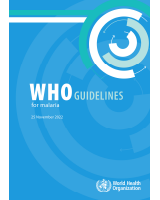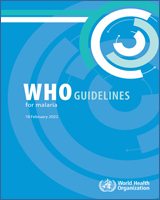Overview
The WHO Guidelines for malaria bring together the Organization’s most up-to-date recommendations for malaria in one user-friendly and easy-to-navigate online platform.
The WHO Guidelines for malaria supersedes 2 previous WHO publications: the Guidelines for the treatment of malaria, third edition and the Guidelines for malaria vector control. Recommendations on malaria will continue to be reviewed and, where appropriate, updated based on the latest available evidence. Any updated recommendations will always display the date of the most recent revision in the MAGICapp platform. With each update, a new PDF version of the consolidated guidelines will also be available for download on the WHO website.
The third version of the Guidelines includes a new section on malaria vaccines and replaces the versions published on 16 February 2021 and 13 July 2021.
Sponsors/Funding: Funding for the development and publication of the Guidelines was gratefully received from the Bill & Melinda Gates Foundation, The Global Fund, the Spanish Agency for International Development Cooperation, Unitaid, and the United States Agency for International Development (USAID).
Suggested citation:
WHO Guidelines for malaria, 18 February 2022. Geneva: World Health Organization; 2022 (WHO/UCN/GMP/2022.01). License: CC BY-NC-SA 3.0 IGO.
General disclaimers. The designations employed and the presentation of the material in this publication do not imply the expression of any opinion whatsoever on the part of WHO concerning the legal status of any country, territory, city or area or of its authorities, or concerning the delimitation of its frontiers or boundaries. Dotted and dashed lines on maps represent approximate border lines for which there may not yet be full agreement.
The mention of specific companies or of certain manufacturers’ products does not imply that they are endorsed or recommended by WHO in preference to others of a similar nature that are not mentioned. Errors and omissions excepted, the names of proprietary products are distinguished by initial capital letters.
All reasonable precautions have been taken by WHO to verify the information contained in this publication. However, the published material is being distributed without warranty of any kind, either expressed or implied. The responsibility for the interpretation and use of the material lies with the reader. In no event shall WHO be liable for damages arising from its use.
The recommendations contained in this publication are based on the advice of independent experts, who have considered the best available evidence, a risk–benefit analysis and other factors, as appropriate. This publication may include recommendations on the use of medicinal products for an indication, in a dosage form, dose regimen, population or other use parameters that are not included in the approved labelling. Relevant stakeholders should familiarize themselves with applicable national legal and ethical requirements. WHO does not accept any liability for the procurement, distribution and/or administration of any product for any use.
This document is a PDF generated from the WHO Guidelines for malaria hosted on the MAGICapp online platform: https://app.magicapp.org/#/guideline/6086. Each time the content of the platform is updated, a new PDF version of the Guidelines will be downloadable on the WHO Global Malaria Programme website to facilitate access where the Internet is not available. Users should note the downloaded PDFs of the Guidelines may be outdated and not contain the latest recommendations. Please consult with the website for the most up-to-date version of the Guidelines (https://www.who.int/teams/global-malaria-programme).
WHO/UCN/GMP/2022.01


